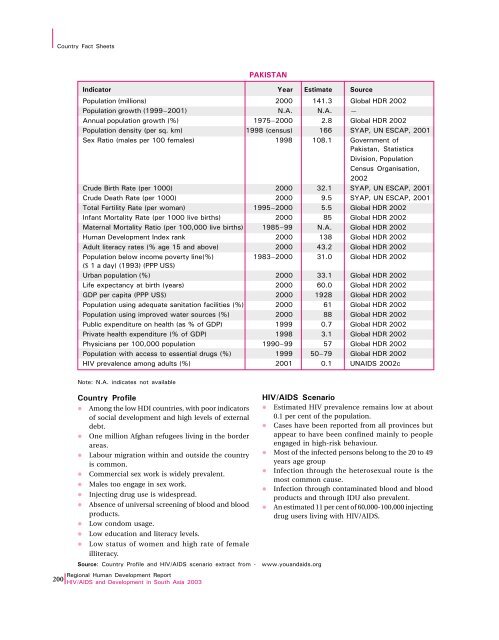Download Report - UNDP Asia-Pacific Regional Centre - United ...
Download Report - UNDP Asia-Pacific Regional Centre - United ...
Download Report - UNDP Asia-Pacific Regional Centre - United ...
Create successful ePaper yourself
Turn your PDF publications into a flip-book with our unique Google optimized e-Paper software.
Country act SheetsPAKISTANIndicator Year Estimate SourcePopulation (millions) 2000 141.3Global HDR 2002Population growth (1999–2001) N.A. N.A. —Annual population growth (%) 1975–2000 2.8 Global HDR 2002Population density (per sq. km) 1998 (census) 166 SYAP, UN ESCAP, 2001Sex Ratio (males per 100 females) 1998 108.1 Government ofPakistan, StatisticsDivision, PopulationCensus Organisation,2002Crude Birth Rate (per 1000) 2000 32.1 SYAP, UN ESCAP, 2001Crude Death Rate (per 1000) 2000 9.5 SYAP, UN ESCAP, 2001Total ertility Rate (per woman) 1995–2000 5.5 Global HDR 2002Infant Mortality Rate (per 1000 live births) 2000 85 Global HDR 2002Maternal Mortality Ratio (per 100,000 live births) 1985–99 N.A. Global HDR 2002Human Development Index rank 2000 138 Global HDR 2002Adult literacy rates (% age 15 and above) 2000 43.2 Global HDR 2002Population below income poverty line(%) 1983–2000 31.0 Global HDR 2002($ 1 a day) (1993) (PPP US$)Urban population (%) 2000 33.1 Global HDR 2002Life expectancy at birth (years) 2000 60.0 Global HDR 2002GDP per capita (PPP US$) 2000 1928 Global HDR 2002Population using adequate sanitation facilities (%) 2000 61 Global HDR 2002Population using improved water sources (%) 2000 88 Global HDR 2002Public expenditure on health (as % of GDP) 1999 0.7 Global HDR 2002Private health expenditure (% of GDP) 1998 3.1 Global HDR 2002Physicians per 100,000 population 1990–99 57 Global HDR 2002Population with access to essential drugs (%) 1999 50–79 Global HDR 2002HIV prevalence among adults (%) 2001 0.1 UNAIDS 2002cNote: N.A. indicates not availableCountry Profilel Among the low HDI countries, with poor indicatorsof social development and high levels of externaldebt.l One million Afghan refugees living in the borderareas.l Labour migration within and outside the countryis common.l Commercial sex work is widely prevalent.l Males too engage in sex work.l Injecting drug use is widespread.l Absence of universal screening of blood and bloodproducts.l Low condom usage.l Low education and literacy levels.l Low status of women and high rate of femaleilliteracy.Source: Country Profile and HIV/AIDS scenario extract from - www.youandaids.org<strong>Regional</strong> Human Development <strong>Report</strong>200 HIV/AIDS and Development in South <strong>Asia</strong> 2003HIV/AIDS Scenariol Estimated HIV prevalence remains low at about0.1 per cent of the population.l Cases have been reported from all provinces butappear to have been confined mainly to peopleengaged in high-risk behaviour.l Most of the infected persons belong to the 20 to 49years age groupl Infection through the heterosexual route is themost common cause.l Infection through contaminated blood and bloodproducts and through IDU also prevalent.l An estimated 11 per cent of 60,000-100,000 injectingdrug users living with HIV/AIDS.
















